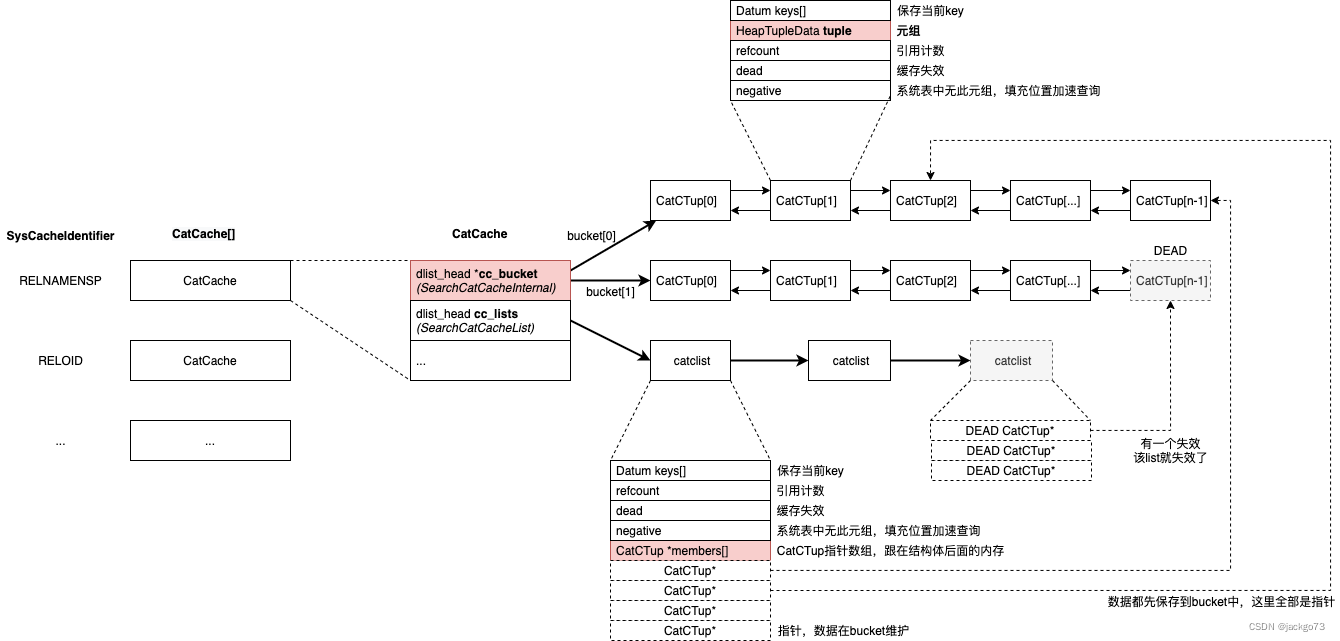1 内存结构和查询步骤
查询步骤概要
- 使用SysCacheIdentifier在CatCache数组中找到对应的CatCache
- 计算hash,按数组index找到bucket
- 找到bucket后,在bucket双向链表中遍历找到CatCTup,元组记录在其中;找到后调整到双向链表头(LRU)
多条查询步骤概要
- cc_lists用与多条数据查询
- 计算hash,按顺序匹配每个catclist,找到catclist
- 如果List可用直接返回。注意catclist中再结构体后面记录了该List指向的所有CatCTup的指针,catclist并不维护tuple内存信息,只是指向CatCTup结构,具体的元组信息(封装在CatCTup中)还是放在bucket中维护。
内存结构见下图:

2 单条查询步骤
提供了四个入口函数,用于不同查询条件个数的场景
extern HeapTuple SearchSysCache1(int cacheId,
Datum key1);
extern HeapTuple SearchSysCache2(int cacheId,
Datum key1, Datum key2);
extern HeapTuple SearchSysCache3(int cacheId,
Datum key1, Datum key2, Datum key3);
extern HeapTuple SearchSysCache4(int cacheId,
Datum key1, Datum key2, Datum key3, Datum key4);
最后全部调入
static inline HeapTuple
SearchCatCacheInternal(CatCache *cache,
int nkeys,
Datum v1,
Datum v2,
Datum v3,
Datum v4)
{
Datum arguments[CATCACHE_MAXKEYS];
uint32 hashValue;
Index hashIndex;
dlist_iter iter;
dlist_head *bucket;
CatCTup *ct;
/*
* one-time startup overhead for each cache
*/
if (unlikely(cache->cc_tupdesc == NULL))
CatalogCacheInitializeCache(cache);
/* Initialize local parameter array */
arguments[0] = v1;
arguments[1] = v2;
arguments[2] = v3;
arguments[3] = v4;
【第一步】算hash找桶
hashValue = CatalogCacheComputeHashValue(cache, nkeys, v1, v2, v3, v4);
hashIndex = HASH_INDEX(hashValue, cache->cc_nbuckets);
【第二步】遍历桶的dlist,找到和nkeys都匹配的tuple
bucket = &cache->cc_bucket[hashIndex];
dlist_foreach(iter, bucket)
{
ct = dlist_container(CatCTup, cache_elem, iter.cur);
if (ct->dead)
continue; /* ignore dead entries */
if (ct->hash_value != hashValue)
continue; /* quickly skip entry if wrong hash val */
if (!CatalogCacheCompareTuple(cache, nkeys, ct->keys, arguments))
continue;
【第二步】找到了!放到dlist头部(LRU)
dlist_move_head(bucket, &ct->cache_elem);
【第二步】找到的tuple是否有neg标记
- 找到了没有negative标记的,把REF++,返回TUPLE。
- 找到了有negative标记的,这种tuple是SearchCatCacheMiss函数查完系统表后,没有匹配的元组,就会在cache中增加一个negative的tuple,表示系统表中没有,省去了下次还要搜索系统表的操作。
/*
* If it's a positive entry, bump its refcount and return it. If it's
* negative, we can report failure to the caller.
*/
if (!ct->negative)
{
ResourceOwnerEnlargeCatCacheRefs(CurrentResourceOwner);
ct->refcount++;
ResourceOwnerRememberCatCacheRef(CurrentResourceOwner, &ct->tuple);
return &ct->tuple;
}
else
{
return NULL;
}
}
【第三步】没找到,去IO对应的系统表
- 如果去系统表中找到了,构造一个tuple放入bucket的dlist中。
- 如果去系统表中没找到,构造一个neg tuple放入bucket的dlist中,表示这条没有,下次直接返回不必查询系统表。
return SearchCatCacheMiss(cache, nkeys, hashValue, hashIndex, v1, v2, v3, v4);
}
3 多条查询步骤SearchCatCacheList
与#2类似:
CatCList *
SearchCatCacheList(CatCache *cache,
int nkeys,
Datum v1,
Datum v2,
Datum v3)
{
...
lHashValue = CatalogCacheComputeHashValue(cache, nkeys, v1, v2, v3, v4);
dlist_foreach(iter, &cache->cc_lists)
{
cl = dlist_container(CatCList, cache_elem, iter.cur);
if (cl->dead)
continue; /* ignore dead entries */
if (cl->hash_value != lHashValue)
continue; /* quickly skip entry if wrong hash val */
/*
* see if the cached list matches our key.
*/
if (cl->nkeys != nkeys)
continue;
if (!CatalogCacheCompareTuple(cache, nkeys, cl->keys, arguments))
continue;
-
与上面单条查询不同的是,这里没有bucket,需要按顺序遍历链表,找到hash匹配的。
-
找到后也是LRU到最前,然后返回即可。
dlist_move_head(&cache->cc_lists, &cl->cache_elem);
/* Bump the list's refcount and return it */
ResourceOwnerEnlargeCatCacheListRefs(CurrentResourceOwner);
cl->refcount++;
ResourceOwnerRememberCatCacheListRef(CurrentResourceOwner, cl);
return cl;
}
ctlist = NIL;
PG_TRY();
{
ScanKeyData cur_skey[CATCACHE_MAXKEYS];
Relation relation;
SysScanDesc scandesc;
/*
* Ok, need to make a lookup in the relation, copy the scankey and
* fill out any per-call fields.
*/
memcpy(cur_skey, cache->cc_skey, sizeof(ScanKeyData) * cache->cc_nkeys);
cur_skey[0].sk_argument = v1;
cur_skey[1].sk_argument = v2;
cur_skey[2].sk_argument = v3;
cur_skey[3].sk_argument = v4;
relation = table_open(cache->cc_reloid, AccessShareLock);
scandesc = systable_beginscan(relation,
cache->cc_indexoid,
IndexScanOK(cache, cur_skey),
NULL,
nkeys,
cur_skey);
-
没找到,去系统表里面搜索。
-
注意搜完了都是添加到bucket中的,list需要的只是把指针记录下来。
ordered = (scandesc->irel != NULL);
while (HeapTupleIsValid(ntp = systable_getnext(scandesc)))
{
uint32 hashValue;
Index hashIndex;
bool found = false;
dlist_head *bucket;
/*
* See if there's an entry for this tuple already.
*/
ct = NULL;
hashValue = CatalogCacheComputeTupleHashValue(cache, cache->cc_nkeys, ntp);
hashIndex = HASH_INDEX(hashValue, cache->cc_nbuckets);
bucket = &cache->cc_bucket[hashIndex];
dlist_foreach(iter, bucket)
{
ct = dlist_container(CatCTup, cache_elem, iter.cur);
if (ct->dead || ct->negative)
continue; /* ignore dead and negative entries */
if (ct->hash_value != hashValue)
continue; /* quickly skip entry if wrong hash val */
if (!ItemPointerEquals(&(ct->tuple.t_self), &(ntp->t_self)))
continue; /* not same tuple */
/*
* Found a match, but can't use it if it belongs to another
* list already
*/
if (ct->c_list)
continue;
found = true;
break; /* A-OK */
}
if (!found)
{
ct = CatalogCacheCreateEntry(cache, ntp, arguments,
hashValue, hashIndex,
false);
}
ctlist = lappend(ctlist, ct);
ct->refcount++;
}
systable_endscan(scandesc);
table_close(relation, AccessShareLock);
/* Now we can build the CatCList entry. */
oldcxt = MemoryContextSwitchTo(CacheMemoryContext);
nmembers = list_length(ctlist);
cl = (CatCList *)
palloc(offsetof(CatCList, members) + nmembers * sizeof(CatCTup *));
/* Extract key values */
CatCacheCopyKeys(cache->cc_tupdesc, nkeys, cache->cc_keyno,
arguments, cl->keys);
MemoryContextSwitchTo(oldcxt);
}
...
cl->cl_magic = CL_MAGIC;
cl->my_cache = cache;
cl->refcount = 0; /* for the moment */
cl->dead = false;
cl->ordered = ordered;
cl->nkeys = nkeys;
cl->hash_value = lHashValue;
cl->n_members = nmembers;
i = 0;
foreach(ctlist_item, ctlist)
{
cl->members[i++] = ct = (CatCTup *) lfirst(ctlist_item);
Assert(ct->c_list == NULL);
ct->c_list = cl;
/* release the temporary refcount on the member */
Assert(ct->refcount > 0);
ct->refcount--;
/* mark list dead if any members already dead */
if (ct->dead)
cl->dead = true;
}
Assert(i == nmembers);
- 构造完成,挂到cc_lists前面,完成搜索。cl->refcount++
dlist_push_head(&cache->cc_lists, &cl->cache_elem);
/* Finally, bump the list's refcount and return it */
cl->refcount++;
ResourceOwnerRememberCatCacheListRef(CurrentResourceOwner, cl);
...
return cl;
}
ps. 补充
PG的双向链表的几个宏实现很漂亮,有兴趣可以研究下。
ilist.h
https://github.com/postgres/postgres/blob/master/src/include/lib/ilist.h
使用时只需要将dlist_node放入struct的任意位置即可,该struct就具有了dlist的所有功能。
struct dlist_node
{
dlist_node *prev;
dlist_node *next;
};
typedef struct dlist_head
{
dlist_node head;
} dlist_head;
// 遍历
dlist_foreach(iter, bucket)
{
ct = dlist_container(CatCTup, cache_elem, iter.cur);
...
...
